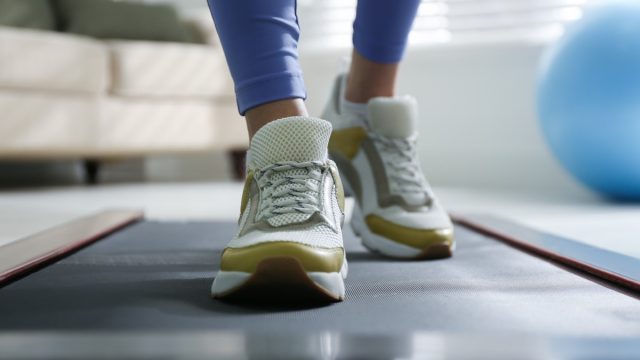Walking Pads Are the Latest Wellness Trend Everyone's Talking About
Certified personal trainers weigh in on why a walking pad might be right for you.

When it comes to fitness and wellness trends, there's always something new to try, whether that's an innovative new workout class or a different kind of diet. But lately, good old-fashioned walking has seen a resurgence as a low-impact option for overall fitness. With the winter months here, however, it can be difficult to find the motivation to bundle up and go for a stroll outside—not to mention trying to find the time to fit it in a hectic schedule. That's where the latest wellness trend, walking pads, come in.
RELATED: Silent Walking Is the Latest Wellness Trend Everyone's Talking About.
Walking pads are also known as folding or under-desk treadmills, but they're not quite the same as your standard issue treadmill. As the name implies, these smaller options are primarily made for walking as opposed to walking and running—and they're often more affordable.
"They typically cannot run at high speeds or on an incline," Rachel MacPherson, Certified Strength and Conditional Specialist (CSCS), certified personal trainer (CPT), and author at Garage Gym Reviews, tells Best Life. "Many walking pads do not have handles or rails as they are designed to be placed under a standing desk. Instead, you'll usually have a screen on the pad displaying your step count and time, among other metrics."
They're easily moved from one spot to another if you purchase one with wheels—and as Rebecca Stewart, CPT, pain-free performance and mobility specialist, explains, some are even more compact.
"Some of them are foldable, and some of them are thin enough that you can store them under a desk or couch when they're not in use. This makes them great for home use to conserve space," she shares.
Walking pads really shot to fame during the height of the COVID pandemic, when gyms were closed and we were spending a lot more time inside—and they're great for those who still work from home. But even if you're back in the office from nine to five, you can hop on the walking pad before the kids are up in the morning, or when you get home and are catching up on Netflix.
"Using a walking pad is an incredibly efficient way to get in more activity during your day while you work, watch TV, scroll on your phone, read a book, or some other pastime you can double up on while you walk," MacPherson says. "Before I got my walking pad, it was difficult to get in my steps during the work day, and busy evenings with family or kids made it tricky to fit in enough steps. Since I've had my walking pad, I have no trouble reaching the number of steps I prefer."
As a bonus, if you feel like you're less active when temperatures drop, this might be an ideal time to look into a walking pad.
"I personally have one for the days when it gets really icy or especially snowy and I don't want to walk outside," Stewart says, adding that in addition to improving physical health, extra steps can also bolster your mental health.
She tells Best Life, "Because getting more movement can help improve your mood and productivity, they are a great supplement to your work routine if you normally would sit at a desk all day. Many walking pad users note increased mental clarity from the additional movement, often easily clocking in 10,000 steps by afternoon."
RELATED: Why Walking Only 3,867 Steps a Day Is All You Need, Science Says.
When it comes to using a walking pad, Rachel Lovitt, CPT, certified mobility specialist, notes that you shouldn't try to design a "complex" walking workout, as you'll likely be multitasking. Instead, she suggests setting a comfortable speed to start, which you can increase as time goes on. You can also introduce intervals, alternating between a more leisurely pace and a faster walk.
"I recommend starting at a comfortable pace for 30 to 60 minutes and working up from there," MacPherson says. "Aim to add 1,000 to 2,000 extra steps per day until you reach the number of steps you aim for. Alternatively, you can track active minutes using a fitness tracker that measures heart rate. Aim for 150 active minutes per week."
MacPherson contends that there aren't really many drawbacks to walking pads, which are "accessible and very easy to use," but if you have balance issues, look for an option that comes with a handle or rail.
Stewart also points out that some walking pads have weight limits, and you should consider the length and width of the tread to ensure you can walk with your normal gait. Beyond that, you'll want to think about sound levels (some walking pads can be loud), how heavy the walking pad is (if you're planning to move it often), what your budget looks like (some walking pads can run upwards of $500), and whether you want to run at all (you'll need a treadmill for that).
In general, experts conclude that walking pads are a great supplement, but it's still important to get outdoors when you can.
"I would not advise walking on a walking pad to completely replace walking outside if possible," Lovitt cautions. "It is very good for your mental health to take breaks away from screens/work and to get fresh air outside."
For more fitness advice delivered straight to your inbox, sign up for our daily newsletter.





















